
Dacrydium cupressinum, commonly known as rimu, is a large evergreen coniferous tree endemic to the forests of New Zealand. It is a member of the southern conifer group, the podocarps. The former name "red pine" has fallen out of common use.

Erica arborea, the tree heath or tree heather, is a species of flowering plant (angiosperms) in the heather family Ericaceae, native to the Mediterranean Basin and Ethiopia, Kenya and Tanzania in East Africa. It is also cultivated as an ornamental.
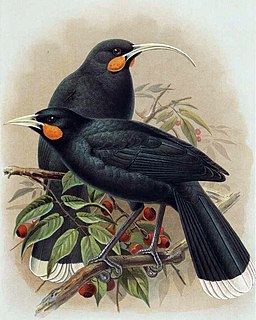
The huia is an extinct species of New Zealand wattlebird, endemic to the North Island of New Zealand. The last confirmed sighting of a huia was in 1907, although there were credible sightings into the 1960s.
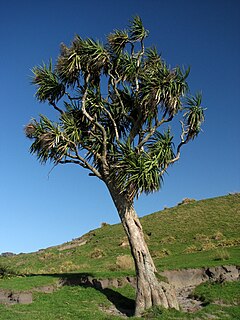
Cordyline australis, commonly known as the cabbage tree or cabbage-palm, is a widely branched monocot tree endemic to New Zealand.
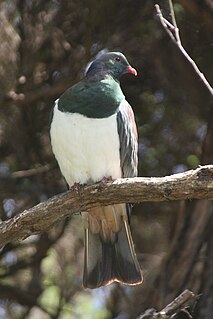
The kererū or New Zealand pigeon is the only pigeon endemic to the New Zealand mainland. A large conspicuous pigeon with distinctive noisy wingbeats, it is the only remaining New Zealand bird capable of swallowing large fruit, and so is an important seed disperser for native trees. Kererū were a significant food source for Māori and one of the two foods harvested at the New Year. Although widespread in both forest and urban habitats, their numbers have declined significantly since European colonisation and the arrival of rats and possums, and hunting them is now illegal.

The tui is a boisterous medium-sized bird native to New Zealand. It is blue, green, and bronze colored with a distinctive white throat tuft. It is an endemic passerine bird of New Zealand, and the only species in the genus Prosthemadera. It is one of the largest species in the diverse Australasian honeyeater family Meliphagidae, and one of two living species of that family found in New Zealand, the other being the New Zealand bellbird. The tui has a wide distribution in the archipelago, ranging from the subtropical Kermadec Islands to the sub-Antarctic Auckland Islands, as well as the main islands.
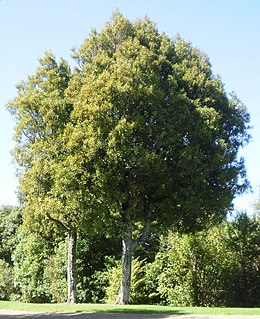
Beilschmiedia tawa, the tawa, is a New Zealand broadleaf tree common in the central parts of the country. Tawa is often the dominant canopy tree species in lowland forests in the North Island and the north east of the South Island, but will also often form the subcanopy in primary forests throughout the country in these areas, beneath podocarps such as kahikatea, matai, miro and rimu. Individual specimens may grow up to 30 metres or more in height with trunks up to 1.2 metres in diameter, and they have smooth dark bark. The te reo Maori word "tawa" is the name for the tree.

Aristotelia serrata, commonly known as wineberry or in the Māori language makomako or just mako, is a small tree in the family Elaeocarpaceae, in the genus Aristotelia, found in the North Island, South Island and Stewart Island of New Zealand.

Gmelina arborea,, locally known as gamhar, is a fast-growing deciduous tree in the family Lamiaceae.

Kunzea ericoides, commonly known as kānuka, kanuka, white tea-tree or burgan, is a tree or shrub in the myrtle family, Myrtaceae and is endemic to New Zealand. It has white or pink flowers similar to those of Leptospermum and from its first formal description in 1832 until 1983 was known as Leptospermum ericoides. The flowers have five petals and up to 25 stamens which are mostly longer than the petals.

Pouteria costata is a small coastal tree native to the northern North Island and to Norfolk Island (Australia). In New Zealand, its common name is tawapou ; on Norfolk Island it is called bastard ironwood. The name costata is from the Latin costatus (ribbed), a reference to the prominently raised primary nerves of the leaves. Pouteria is a genus of approximately 300 species in the tropics of America, Asia, Australia and the Pacific. A Pouteria species found in other Pacific Islands is sometimes erroneously included in P. costata.

The Japanese wood pigeon is a species of bird in the genus Columba in the family Columbidae. It is found along shorelines of the East China Sea. They are believed to be the largest representative of Columba, at 550 grams (1.2 lb) and 43 cm (17 in). Its natural habitats are temperate forests and subtropical or tropical moist lowland forests. The species is in decline owing to habitat loss, habitat degradation, deforestation and hunting. This wood pigeon is endemic to the laurel forest habitat.

Ōhuiarangi / Pigeon Mountain is a 55 m (180 ft) high volcanic cone at Half Moon Bay, near Howick and Bucklands Beach, in Auckland, New Zealand. The cone forms the last part of volcanic activity that lasted many years. An earlier explosive eruption, created the prominent tuff ring that is still clearly visible extending in an arc south of Sunderlands Road. Two much smaller craters were formed to the north west of the main cone. The smaller lies buried under Pigeon Mountain Road outside number 18, and the other forms 'Heights Park' – a private reserve for the owners of 29 – 41 Pigeon Mountain Road and 14 – 36 Prince Regent Drive and 33 – 39 Tyrian Close. It forms part of the Auckland volcanic field and is popular for scientific school trips.
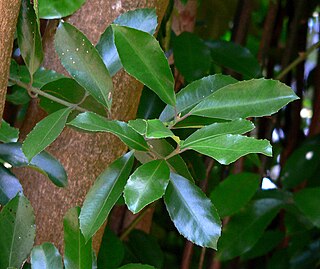
Hedycarya is a genus of dioecious trees and shrubs of the family Monimiaceae. Species occur in South East Asia, New Caledonia, Australia and Polynesia including New Zealand. The genus was named and formerly described in 1776 by botanists Johann and Georg Forster in Characteres Generum Plantarum . The limit of the genus may require change as it appears paraphyletic in phylogenetic analyses, with the genera Kibaropsis and Levieria nested in it.
Pigeonwood is a common name for several trees and may refer to:
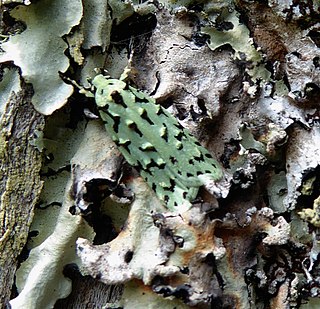
Izatha peroneanella, also known as the small lichen moth or the green lichen tuft, is a moth of the family Oecophoridae. It is endemic to New Zealand, where it is found throughout the North Island, other than the Aupouri Peninsula of Northland.

Pigeon Island is located in at the northern end of Lake Wakatipu in New Zealand near the township of Glenorchy. It is 170 hectares in size and is the largest island in the lake. In 1884, during Queen Victoria's reign, it was gifted by the Crown as a reserve to the people of Queenstown district for their use and enjoyment.
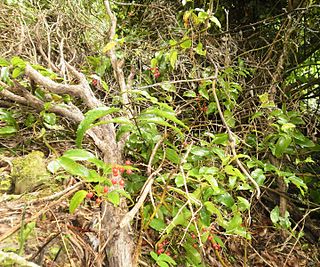
Ripogonum scandens, is a common rainforest vine native to New Zealand. It can also grow in areas of swamp.

Trounson Kauri Park is a mainland island in the Northland Region of New Zealand. Characterised by its Kauri trees, it was named after James Trounson, who gifted the forest to the Department of Conservation.


















